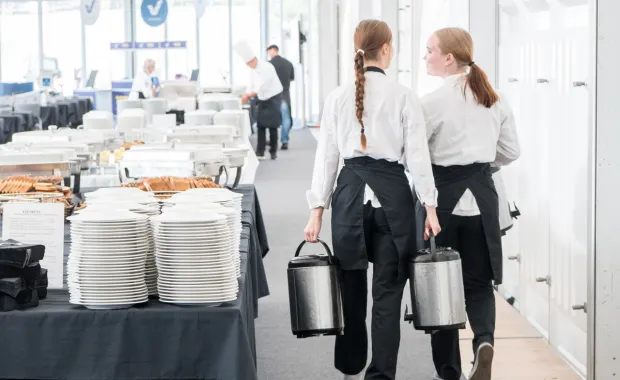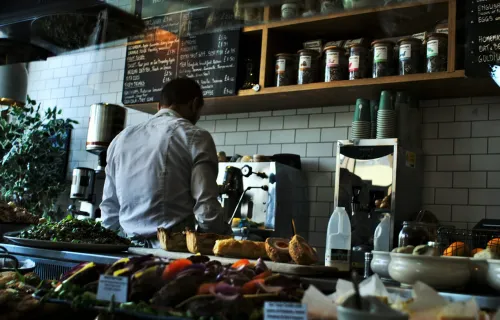Salpaus Further Education is one of the largest vocational education providers in Finland. With food waste as a persistent challenge, its catering facilities set a goal to reduce food waste, improve food service operations and generate environmental benefits.
Research shows that approximately 25% of edible food is thrown away in restaurants and catering outlets every year. At Salpaus Further Education campuses, around 2,500 students, staff, and customers enjoy meals at their six catering outlets daily. Food waste is a persistent challenge, so Salpaus set a target to reduce waste, improve operations and gain environmental benefits.
Gaining overall control of food waste
Salpaus wanted a tool with reporting and waste management functionalities to enable its staff to address food waste problems and develop efficient ways of working.
Rollout from a single outlet to all restaurants
One of Salpaus’ catering outlets started using CGI Waste Manager for one school year, reducing food waste costs from 17 cents to less than 7 cents per customer during the eight-month pilot. As a result, Salpaus deployed the solution to the rest of its catering outlets.
“We have set ourselves strict sustainable development targets; for example, to increase the use of organic and locally-produced food in our meals,” added Jurkkola. “The less raw material and already prepared food is thrown away, the more we can invest in reaching our goals.”
Overall, with CGI Waste Manager, Salpaus’ pilot catering outlet reduced food waste costs by 59%. As a result, the solution was deployed to the rest of its catering outlets, significantly improving its kitchen operations.

Our goal was to be able to monitor kitchen food waste on a concrete level instead of speculating. It is too easy to concentrate on waste caused by customer leftovers, which, in fact, is something we cannot even control.
Program Manager at Salpaus Further Education
Continuous improvement in kitchen operations
By collecting data in real time, CGI Waste Manager helps drive continuous improvement in food preparation. It enables food services providers to yrack and manage accumulated waste, drive efficiencies and save costs and reduce carbon dioxide (CO2) emissions. “Previously, we used to measure biowaste originating from customer leftovers for a duration of about four weeks each year,” explained Jurkkola. “Measuring biowaste was really difficult and caused a lot of extra work for our kitchen personnel. Often, staff recorded the figures on an Excel spreadsheet without any further examination of the results, let alone acting upon them. Now these measurements are one of the core routines in our kitchens, and we have received a lot of positive feedback from our customers on how the results have improved our services.”

Quick analysis through visual data
With CGI Waste Manager, waste management is even easier during peak hours. Staff can weigh food waste and enter the results in the online application, with segmented and visualized data stored in the cloud.
“Seeing the amounts of food waste as concrete figures in kilograms and euros made us realize what we could do to improve our operations,” shared Jurkkola. ”Previously, we had no way of visualizing the overall situation; our only guidelines were each employee’s own estimations on how much food was wasted during preparation. I’m happy to tell that now we are all motivated to reach our common goal of reducing the amount of food waste.”
Kitchen staff benefits from a clear view of food waste in their outlets with one glance, regardless of time and place. User-friendly reports with illustrations also provide insight on ways to improve operations.
“Waste management complements our company image and environmental program perfectly,” said Jurkkola. “The solution is easy to use, and the reports are clear and illustrative. Monitoring and reducing food waste has become something that the whole staff boasts about, and our shared pride in our actions is often mentioned in personnel meetings.”
Driving environmental sustainability
Food waste has a major environmental impact on the entire food production life cycle—from agriculture, to transport, to food storage and preparation. In fact, ISO 14001 environmental standards recommend that food service companies address their environmental impact on the entire food production chain in their environmental sustainability strategies.
CGI’s clients in the food services industry estimate that minimizing food waste is the most efficient way of developing more sustainable strategies. Through CGI Waste Manager, we help them to achieve this.
"By using CGI Waste Manager, some of our clients have saved up to 9% in raw material costs. Benefits also realized very quickly; the solution pays for itself in 3 to 10 months." Eveliina Lindell, Circular Economy Specialist, CGI
*CGI Waste Manager is part of the CGI Aromi solution portfolio.






